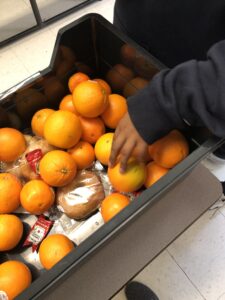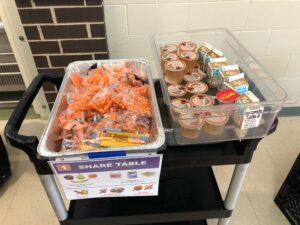The Food and Agriculture Organization of the United Nations estimates that almost one-third of the world’s food goes uneaten. Most of this food waste goes to landfills, helping to fuel climate change. While there are many industries that contribute to this large-scale problem, schools are a major player. The World Wildlife Fund estimates that, on average, each student produces approximately 39.2 pounds of food waste per year.

What can be done in schools to ensure that perfectly edible food does not end up in the landfill? Share tables, where students are able to return any unopened food they received in their school lunch so that it may be either donated, taken by another student, or used by the school at a later time, are becoming an important solution in K-12 schools. Share tables can simultaneously reduce food waste while also serving as a method of food recovery to ensure that those in need of food are receiving it. Although the operating procedures for share tables may look different depending on the school, all share table programs feature a designated place for students to leave unopened and uneaten school-provided food.
Recovering food through the use of share tables is supported by ISBE and the USDA. Be sure to check with your local health department to determine the type of items that can be collected. Additionally, it is important to educate students about the share table, its purpose, and best practices for successful implementation.
Although share tables are a relatively new idea, many schools are already starting to make essential changes to their policies in order to provide for their use across school districts. The Oakland Unified School District (Oakland USD) and the San Diego Unified School District (San Diego USD) have been two pioneers in the push for share tables in schools. According to the Center for Green Schools, between 2016 and 2018, San Diego USD diverted 381,000 pounds of food waste from the landfill.
Share tables are also making a positive impact here in Illinois. Waste audits conducted at Oak Terrace Elementary School in Highwood, IL measured 16 lbs of share table eligible items that were diverted from the landfill on the day that they launched their Zero Waste Schools Program (ZWS). Similarly, Carl Von Linne Elementary School in Chicago and Conley Elementary School in Algonquin diverted 33 lbs and 95.12 lbs of edible food respectively during their waste audits with ZWS. These schools continue to recover substantial quantities of food each day thanks to their continued use of share tables.
 If you are interested in recovering food, there are an abundance of resources to help you introduce this initiative in your local school community. Seven Generations Ahead’s Zero Waste Schools Toolkit features a curated collection of resources under the Share Tables and Food Recovery Options section. The Food Waste Reduction Toolkit for IL Schools has everything you need to get a share table started, including detailed steps about set up and sample standard operating procedures from districts with successful food recovery programs.
If you are interested in recovering food, there are an abundance of resources to help you introduce this initiative in your local school community. Seven Generations Ahead’s Zero Waste Schools Toolkit features a curated collection of resources under the Share Tables and Food Recovery Options section. The Food Waste Reduction Toolkit for IL Schools has everything you need to get a share table started, including detailed steps about set up and sample standard operating procedures from districts with successful food recovery programs.
If you want to do your fair share to reduce food waste at your school, share tables are a great place to start!
